
THE HOUSEHOLD CAVALRY:
The Household Cavalry now consists of an operational armoured reconnaissance regiment, stationed in Windsor (the Household Cavalry Regiment or HCR) and a mounted ceremonial regiment, stationed in London (the Household Cavalry Mounted Regiment or HCMR). The Soldiers of The Life Guards and the Blues and Royals equally mann the HCR and HCMR.
The Household Cavalry was formed in 1992, under the Options for Change reforms, by the union of The Life Guards and the Blues and Royals in order to preserve the distinct identities of the regiments.
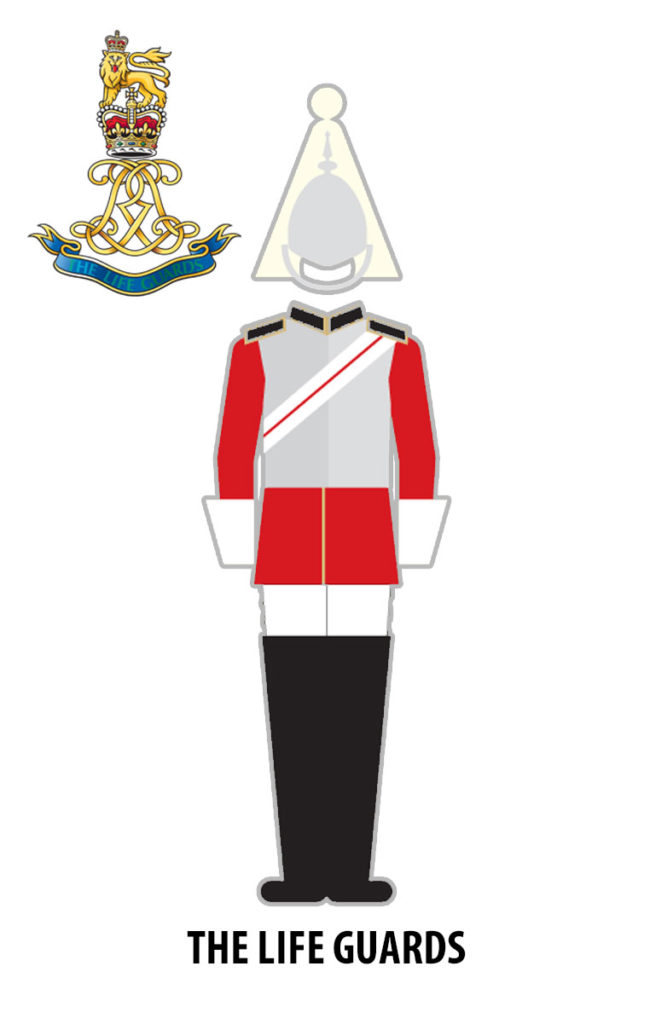
The Life Guards:
Formed in 1660, The Life Guards finds origins in a group of loyal gentlemen who accompanied King Charles II to the continent during his exile (1652-59) and formed themselves into a military bodyguard to protect The Sovereign. They escorted His Majesty back to England at the Restoration in 1660. Since then the Regiment has undergone many changes in title and establishment but has always remained the senior regiment of the British Army. As gentlemen served in all ranks, they rejected the term Sergeant (associated with ‘servant’) in favour of Corporal of Horse, a tradition which persists. The troops were re-organised in 1788 into the 1st and 2nd Regiments of Life Guards, and remained as such until 1922, when they were amalgamated into one regiment known as The Life Guards.
Motto: Honi soit qui mal y pense (“Evil be to him who evil thinks”)
Uniform: The uniform of The Life Guards is distinguishable by their red tunics with white plumes on their helmets.
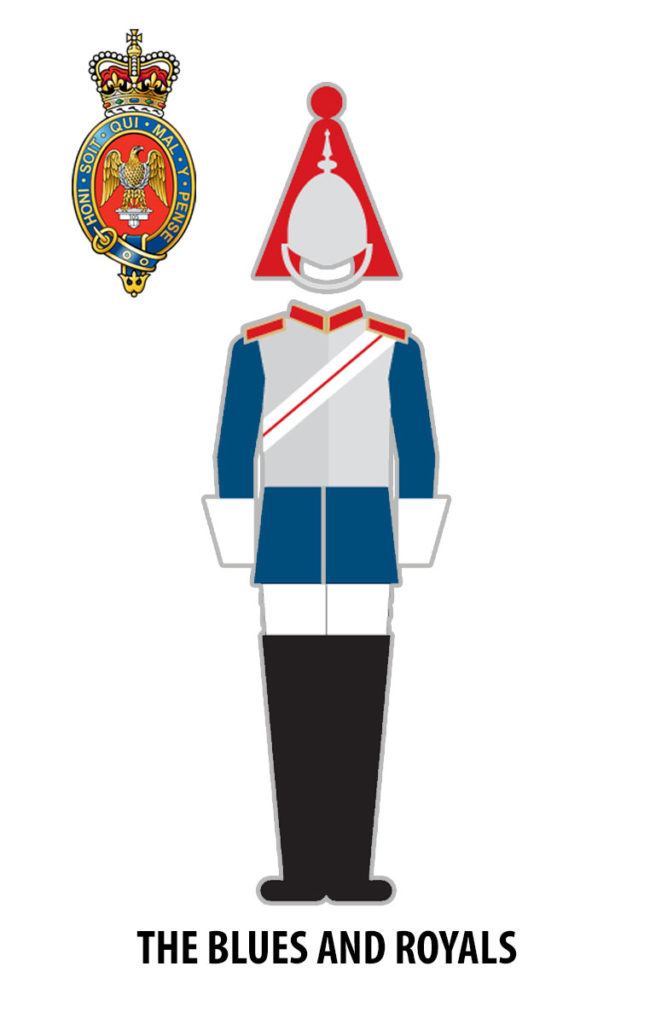
The Blues & Royals (Royal Horse Guards and 1st Dragoons):
The Blues and Royals was created in 1969 by the amalgamation of two famous cavalry regiments, the Royal Horse Guards and The Royal Dragoons. The Royal Horse Guards (The Blues) were descended from a Parliamentary Regiment of Horse, which King Charles II re-raised when founding the Regular British Army in 1661. Always known as The Blues from the colour of their tunics, the Regiment became a favourite of King George III. They were promoted to Household Cavalry status in 1813, although since their formation they had carried out duties similar to those of The Life Guards. The 1st Dragoons (Royals) were originally raised in London in 1661 to form part of the Garrison of Tangiers and were formerly known as the Tangier Horse. On their return to England in 1683, they were re-designated by Charles II as “Our Own Regiment of Dragoons” and granted precedence over all other cavalry regiments of the Line. The Royals also played a distinguished part in the Battle of Waterloo when they captured the Colour of Napoleon’s 105th Infantry Regiment surmounted by an Eagle. This is commemorated today in the uniform of the amalgamated Regiment, by the wearing of an Eagle on the left sleeve of their tunics, and in the Regimental emblem.
Motto: Honi soit qui mal y pense (“Evil be to him who evil thinks”)
Uniform: The uniform of The Blues and Royals is distinguishable by their blue tunics with red plumes on their helmets.
The official website for the Household Cavalry can be found here.
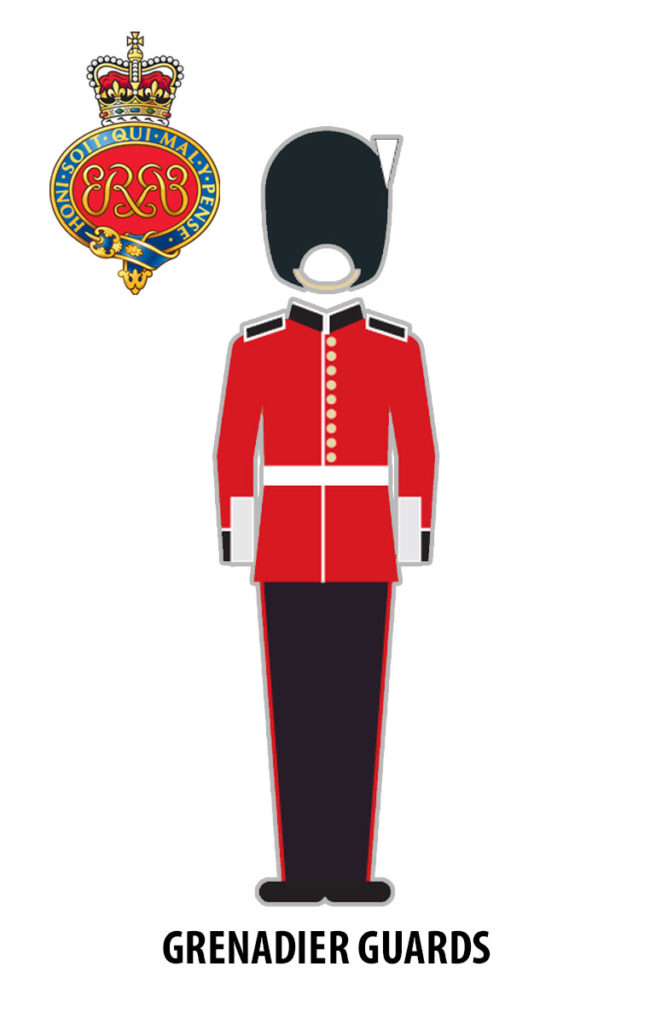
GRENADIER GUARDS:
Formed 1656 by King Charles II while in exile in Flander, the Grenadier Guards are the most senior infantry regiment in the British Army. All new Guardsmen go to Nijmegen Company stationed in Wellington Barracks, London, focusing on Public Duties and further development prior to onward posting in Aldershot. The Grenadier Guards have deployed on operational tours to Afghanistan as well as Iraq and have done much adventurous training such as abseiling and kayaking. In 2017 Duke of York took over from his Father the Duke of Edinburgh as the Royal Colonel. They also had a busy year on exercises such as Cambrian Patrol, Wessex Storm and Noble Jump which was a meant being based in Romania for a month. The Regiments’ soldiers take part in many sports and have even had one Guardsman compete in the Winter Olympics in Bobsleighing.
Motto: Honi soit qui mal y pense (“Evil be to him who evil thinks”)
Uniform: Grenadier Guards wear a white plume on the left side of their bearskin and their buttons on Tunics are grouped singular.
The official website for the Grenadier Guards can be found here.
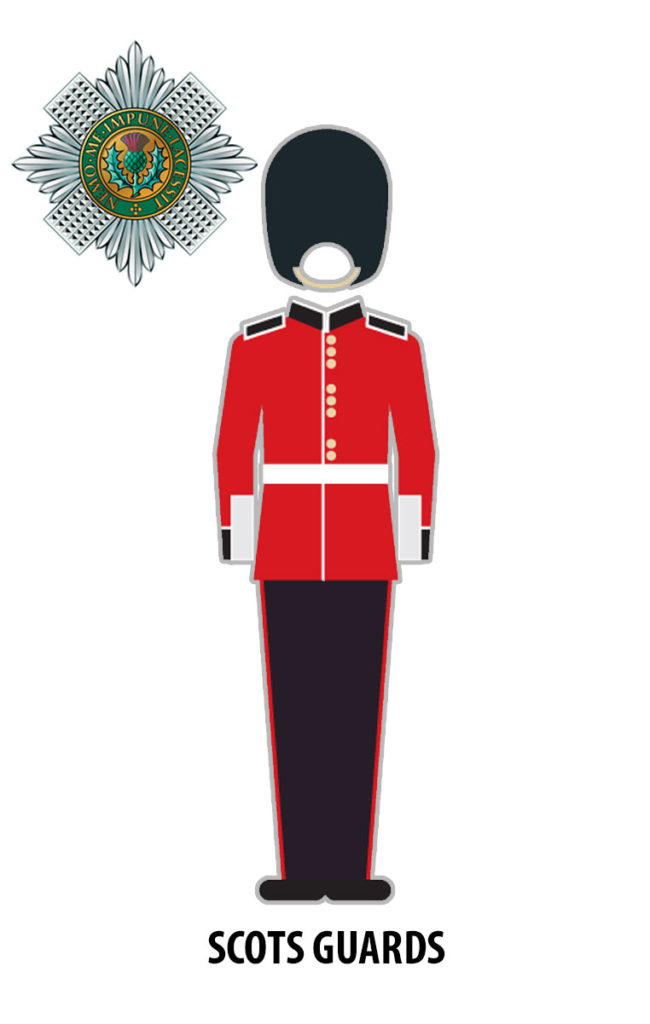
SCOTS GUARDS:
Formed in 1642 by Archibald, 1st Marquis of Argyll on orders of King Charles I, the Scots Guards are the 3rd Regiment of the Foot Guards. All new Scots Guardsmen passing out training are posted to F Company which is based in London. They then go on to join the Battalion based in Aldershot. They have deployed on exercises to Canada and Zambia. They took part on a month long exercise that involved working with the German Army. During this time, F Company in London celebrated St Andrew’s Day in London. They have also competed in skiing competitions in the Alps every year and recently competed in the Brigade Operational Shooting competition, during which they won best overall team as well as best overall shot. The Scots Guards most recently deployed on exercise to Canada and a deployment to Cyprus on an operational tour.
Motto: Nemo Me Impune Lacessit (“No One Assails Me With Impunity”)
Uniform: The Scots Guards’ bearskin have no plume and their tunic buttons are grouped in threes.
The official website for the Scots Guards can be found here.
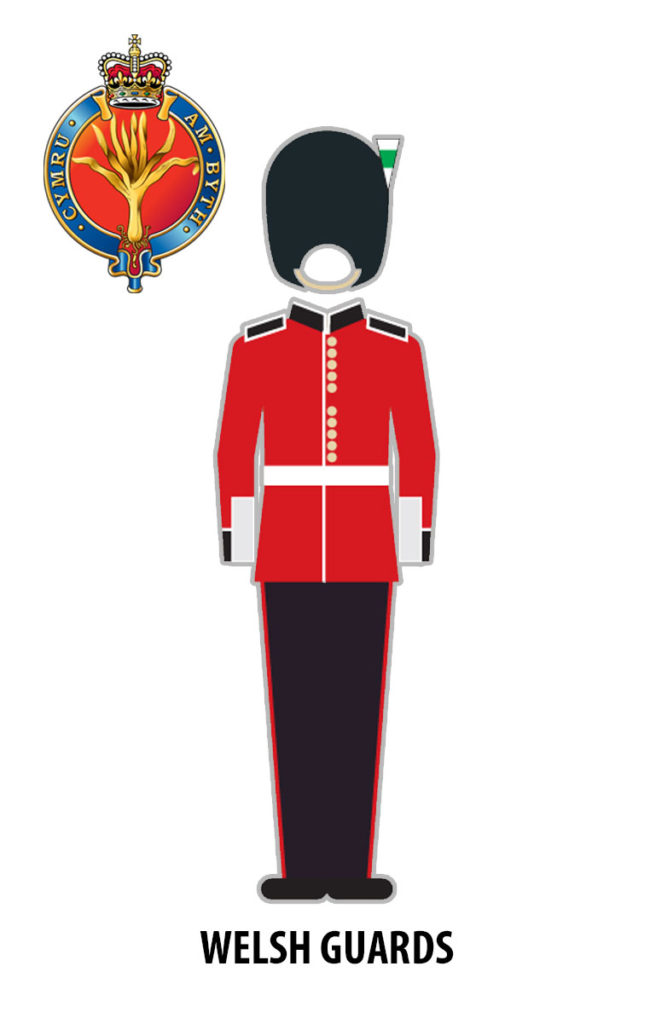
WELSH GUARDS:
The Welsh Guard Regiment was raised on 26 February 1915 by order of King George V to complete the national complement of regiments of Foot Guards identified with the countries of the United Kingdom, the last of the Guards to be created. Once completing their training, they join the Battalion based in Pirbright. Recently they have taken part in many exercises in preparation for their recent deployment to Afghanistan. This included live firing exercises in Lydd and Sennybridge as well as a month long exercise in Romania, working with Romanian Land Forces. They hold the title of the Household Division Boxing Champions in 2017. They also have a rugby team with many Guardsmen who play for teams outside of the Battalion. Each year the Welsh Guards celebrate St Davids Day with a parade.
Motto: Cymru am Byth (“Wales Forever”)
Uniform: Welsh Guards wear their White/Green/White plume on the left side of their bearskins and buttons on their tunics are in fives.
The official website for the Welsh Guards can be found here.
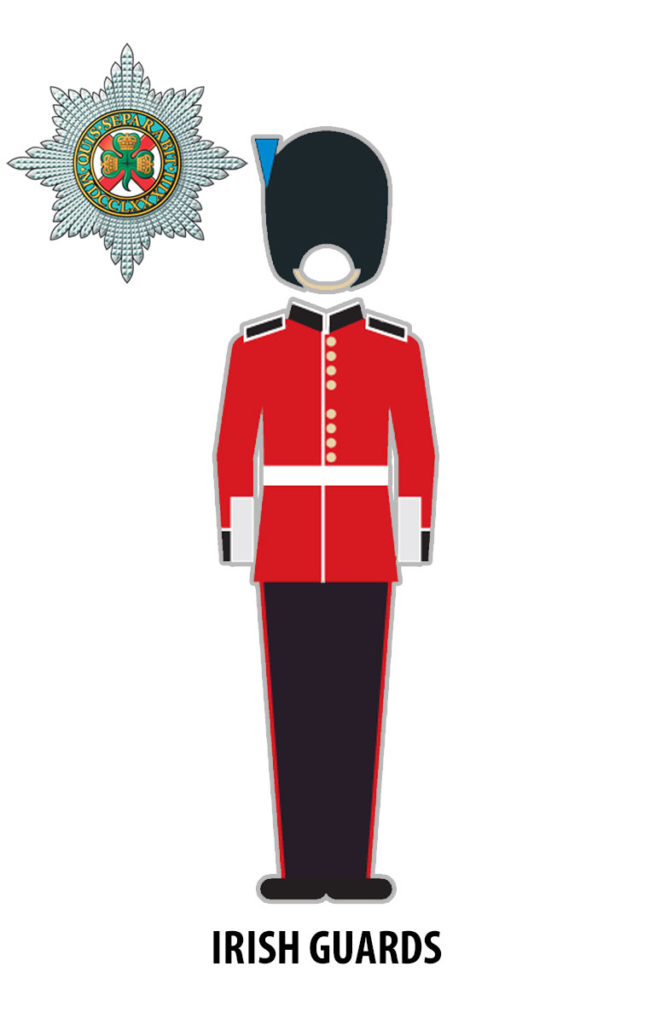
IRISH GUARDS:
The Irish Guards regiment was formed on 1 April 1900 by order of Queen Victoria to commemorate the Irishmen who fought in the Second Boer War for the British Empire. Once completing their training, new Guardsmen join the Battalion based in Hounslow. They have deployed on exercises to Thailand and Kenya where they also had time to explore the local areas once their training had finished. They are the winners of this year’s Lawson’s Cup, an athletics competition in which all the Regiment’s in the Division compete against each other. They recently went on a month long Battlecamp in Thetford and competed in the International Reconnaissance Competition. Each year they celebrate St Patrick’s Day with a parade which is usually attended by the Duke and Duchess of Cambridge and are handed shamrocks. The Irish Guard’s collar is adorned with a shamrock on either side.
Motto: Quis Separabit (“Who Shall Separate Us”)
Uniform: A St Patrick’s blue plume is worn on the right side of the bearskin and buttons on their tunics are spaced in fours.
The official website for the Irish Guards can be found here.
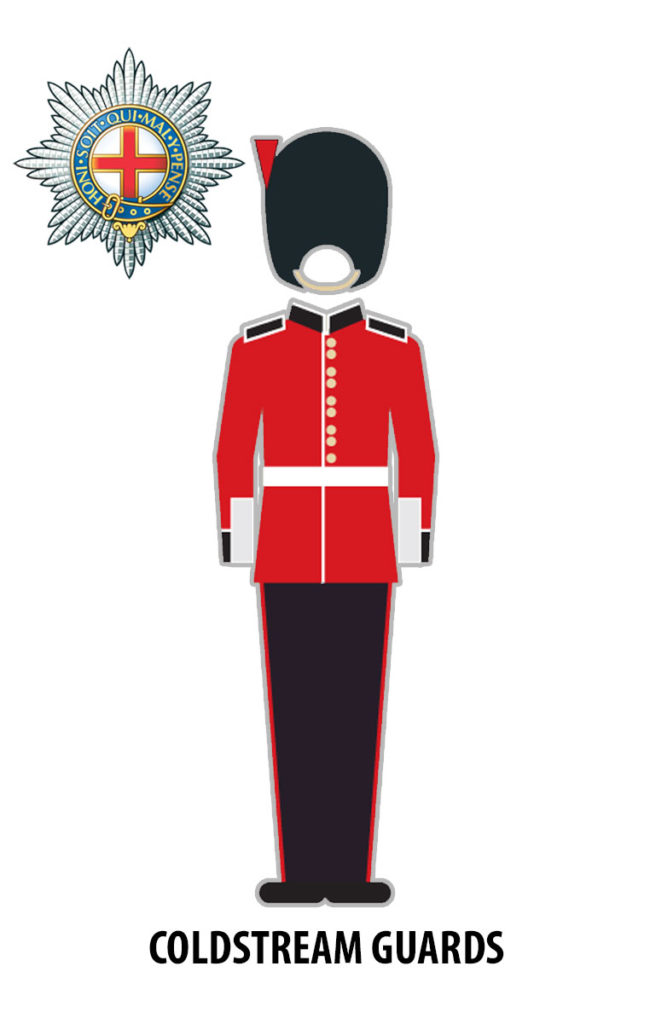
COLDSTREAM GUARDS:
Formed in 1650, Coldstream are famous for being the oldest regiment in the British Army in continuous service. Recruits complete the six-month Combat Infantry’s Course at the Infantry Centre, Catterick. Once they become Guardsmen they go to 7 Company based at Wellington Barracks, London, before being posted to the Battalion at Windsor. They have been deployed to Afghanistan as well as completed exercises in Belize and Kenya. They have also had the opportunity to go out to Zambia and help train soldiers in the Zambian Army. In 2017, they were streetliners for the Queen’s Birthday Parade while the Irish Guards trooped their colour. Many of the soldiers also went to the Falklands on a three-month exercise at the beginning of the year. A select few embarked on HMS Ocean in Gibraltar to sail to the Caribbean on Operation Rumen to help with humanitarian aid and disaster relief in the Caribbean following hurricane Irma. As well as this, soldiers have taken part in sailing trips around the world and the football team has been on many tours across Europe.
Motto: Nulli Secundus (“Second To None”)
Uniform: Coldstream guards wear a red plume on the right side of the bearskin and buttons in pairs on the tunic.
The official website for the Coldstream Guards can be found here.


